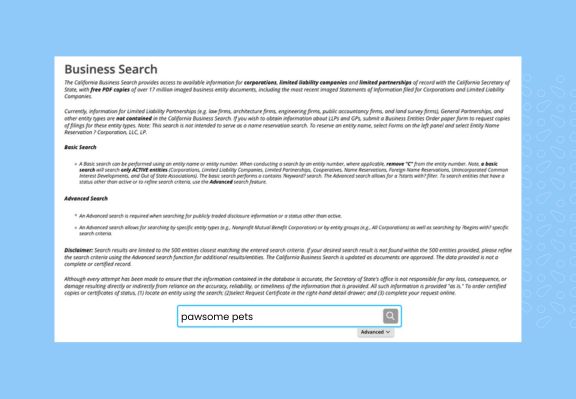Names have power. When you hear “Apple,” you probably think of innovation, sleek design, and cutting-edge technology.
When you hear “McDonald’s,” you think of fast food, golden arches, and the familiar taste of a Big Mac.
And when you hear “Coca-Cola,” you think of refreshment, the iconic red and white logo, and the unmistakable taste of a classic soda.
While brand recognition certainly plays a significant role in these associations, a business’s name lays the groundwork for establishing that recognition.
In this blog, you’ll learn how to brainstorm name ideas, check business name availability, and ultimately secure a name that aligns with your brand vision and paves the way for your success.
Table of contents
- What is a business name?
- Why your business name matters
- 3 reasons you must verify business name availability
- How to check if a business name is taken
- Expert tips for picking a business name
- What to do if your desired business name is taken
- Common pitfalls to avoid when choosing a business name
- Tools for generating a unique business name
- Business name availability FAQs
- Grow your business with Birdeye
What is a business name?
A business name refers to the official, legal name under which your company operates. It is more than just a branding decision — registering your business name establishes your company as a recognized legal entity.
Why your business name matters
Far more than just a label, your business name is a cornerstone of your brand identity. It shapes brand perception and builds brand recognition.
But the significance extends beyond just branding. Your business name also carries legal protections. Trademark law provides exclusive rights to registered names and prevents unfair use by other entities.
An original, properly vetted business name reduces infringement risks while securing your exclusive branding and usage rights — a critical strategic asset.
Your name also impacts your online presence and search engine optimization (SEO). From local listings to social media profiles, consistency in your name across platforms strengthens your visibility. A taken or unavailable domain name complicates digital marketing efforts.

3 reasons you must verify business name availability
Prior to naming your business, a comprehensive due diligence check prevents headaches in the long run. Let’s look at three reasons why checking business name availability is a step you can’t afford to miss.
1. Mitigate legal risks
If another business has an active registered trademark on your selected name, using it can lead to expensive litigation, settlement demands, and harsh penalties, even if unintentional. Proper searches help avoid costly oversights.
2. Strengthen online visibility
If your business name is already widely used, you’ll struggle to build recognition and rank well online. An original, thoroughly vetted name simplifies marketing and helps you stand out.
3. Adhere to registration requirements
Most states will only approve applications for entity formation if your chosen business name is registered or trademarked. Comprehensive vetting provides peace of mind that your name will pass registrations.
Birdeye – all-in-one platform
Secured your business name? Now grow with Birdeye.
How to check if a business name is taken
So, you’ve come up with the perfect business name idea, but now you’re wondering: Is this business name available? To ensure that your prospective company name is one of a kind, complete the following steps.
1. Search the federal trademark database
Look up your proposed name in the United States Patent and Trademark Office’s (USPTO) free database. This verifies that no identical active trademarks exist at the national level.
To perform a USPTO search:
- Go to the USPTO Search System
- Enter your desired business name in the Search Term field
- Select Word Mark for the Search Type
- Click Submit Query

Carefully review results for any direct matches or similar names. Active registered names might present an infringement risk.
2. Check state business entity databases
Even if no federal trademarks exist, state-level entities may already be using your business name. Every state government maintains its own registration portal — be sure to search state-specific portals for any location in which you plan to operate.
For example, in California, you would:
- Go to the California Business Search tool
- Enter your proposed business name into the search bar
- Scan results for any identical or deceptively similar matches

3. Search local business directories
Expanding your search to local business directories and listings will help uncover potential branding conflicts. Look for existing profiles on sites like:
- Google My Business
- Local chambers of commerce
- Industry-specific directories
4. Verify domain name availability
Next, verify domain availability. Whenever possible, aim to incorporate your business name in your URL. This helps reinforce brand consistency and makes it easier for potential customers to remember and find your website.
Use a domain name search engine like GoDaddy Domains or Squarespace Domains to find and purchase available URLs.
5. Check social media handle availability
For branding and visibility purposes, your business name, URL, and social media handles should match.
Remember: Just because your business name is unclaimed at federal, state, and domain levels doesn’t mean matching social media handles will be available. Ensure that your desired social media handles are available before officially registering your business name.
6. Search international trademarks
If you plan to expand your brand globally, look up your business name in the World Intellectual Property Organization’s Global Brand Database. Doing this will allow you to uncover any conflicting trademarks registered outside the US.
To search the Global Brand Database:
- Navigate to the database
- Enter your desired business name into the search bar
- Review results for identical or closely matching names that may pose an infringement risk
- Pay close attention to marks filed in regions where you may consider expanding in the future
If you’re confident your business will remain locally focused, an international trademark search is likely unnecessary.
Expert tips for picking a business name
Beyond simply checking availability, how do you choose the perfect business name? Follow these best practices as you brainstorm:
- Make it memorable: Avoid overly complex or confusing names. Short, crisp, and punchy names tend to stick in customers’ minds best.
- Emphasize key differentiators: Work your niche, specialty, or unique values into the name to stand out from competitors.
- Ensure web searchability: Pick a name without common words or phrases that produce irrelevant search results and bury your listings.
- Keep visual appeal in mind: Verify that your name looks clean and professional when rendered as signage, logos, branding, etc.
- Say it out loud: Opt for something that sounds clear when spoken since customers will refer to you verbally.
- Think about scalability: Choose a name that has the power to grow beyond just your local area. Expanding your service area might be tricky if you name your business after the city you live in.
- Solicit objective feedback: Get unbiased input from family, friends, or business partners before finalizing your business name choice.
Following these tips will lead to selecting a name that checks all the boxes – alignment with your brand identity, availability for registration and online use, and memorable resonance with your audience.
What to do if your desired business name is taken
There are a lot of businesses out there, so your desired business name may already be in use. Don’t panic! You have several options to find an available alternative aligned with your brand vision:
- Try unique name spellings: Get creative with alternate spellings like “Adventur” instead of “Adventure.”
- Incorporate founder names: Add your last name or initials to make it distinctive. For example, “Anderson’s Lush Landscaping” or “John’s Lush Lawns.”
- Combine generic terms: Create a unique and memorable fusion that sets your business apart, such as “NutriPaws Emporium.”
If no suitable alternatives come to mind, take a step back and revisit your brainstorming process with a fresh perspective. The payoff of finding an evocative, available business name is worth the effort.
Common pitfalls to avoid when choosing a business name
The business naming process presents ample room for missteps. Here are some common pitfalls to be aware of — and tips to avoid them:
- Only checking one database: Just searching the USPTO trademark database isn’t enough. Be sure to also check state and local registries to fully validate availability.
- Not considering web visibility: Opting for trendy obscure names might seem clever, but it can hurt SEO and marketing later on. Ensure your name is web-friendly.
- Prioritizing cleverness over clarity: Ultra-creative or abstract names usually aren’t memorable. Opt for something customers can easily say, type, and recognize.
By being mindful of these potential pitfalls upfront, you’ll be well-positioned to choose a name that aligns with your brand vision and drives growth for years to come.
Tools for generating a unique business name
Coming up with a business name requires creativity, strategic thinking, and a good deal of patience. It’s an endeavor that many people do not enjoy — and it’s just one task on the mile-long to-do list that comes with starting a business.
Fortunately, online tools can automate and streamline much of the process. Here are a couple of tools to try:
- Namecheckr: A consolidated dashboard that checks trademarks, domains, directories, and social networks. It also provides suggestions if your name is taken.
- Namelix: This tool provides AI-generated business names that are short and brandable.
- BrandCrowd: Provides AI-generated business name recommendations that match your brand’s personality and are sure to resonate with your target audience.
Business name availability FAQs
To check business name availability, use sites and tools like:
– USPTO’s free database
– Secretary of State business entity search tools
– Domain name search engines like GoDaddy or Squarespace
– Local review sites like Google
You should also check social media to see if other brands operate under your desired name.
Using a taken business name can lead to legal issues, including trademark infringement. It can also lead to poor brand awareness and other marketing headaches. Consult with a legal expert to understand the potential consequences and explore alternative naming options.
If your desired business name is taken, you may need to get creative. Consider:
– Altering the spelling or order of the words
– Adding a unique descriptor or geographic location to the name
– Brainstorming new name ideas
– Consulting with a branding expert for alternative suggestions
Yes, it’s possible to change your business name in the future, though it may require a substantial amount of paperwork, re-branding, and notification to the relevant authorities.
Ensure your business name reflects your business values, target audience, and industry. It should be memorable, easy to spell, and indicative of the products or services you offer.
Grow your business with Birdeye
Once you’ve got your name picked out and secured, you’re off to the races. It’s time to build awareness, connect with customers, and accelerate growth.
Growing a business is no small task. Luckily, we’re here to help. Birdeye is an all-in-one solution that offers everything business owners need to run their small businesses. With our platform, you can:
- Collect and manage reviews
- Get more done in less time with AI
- Streamline social media management
- Get found and chosen online
And so much more. Ready to get started? Learn more here.

Originally published


![this is a 1 / 1 – [Feature image] of the blog about 31 irresistible car sales email templates to close more deals.](https://birdeye.com/blog/wp-content/uploads/Feature-image-31-irresistible-car-sales-email-templates-to-close-more-deals-375x195.jpg)
![[Feature image] Are you on these 40+ powerful eCommerce review sites blog](https://birdeye.com/blog/wp-content/uploads/Feature-image-Are-you-on-these-40-powerful-eCommerce-review-sites_-375x195.jpg)